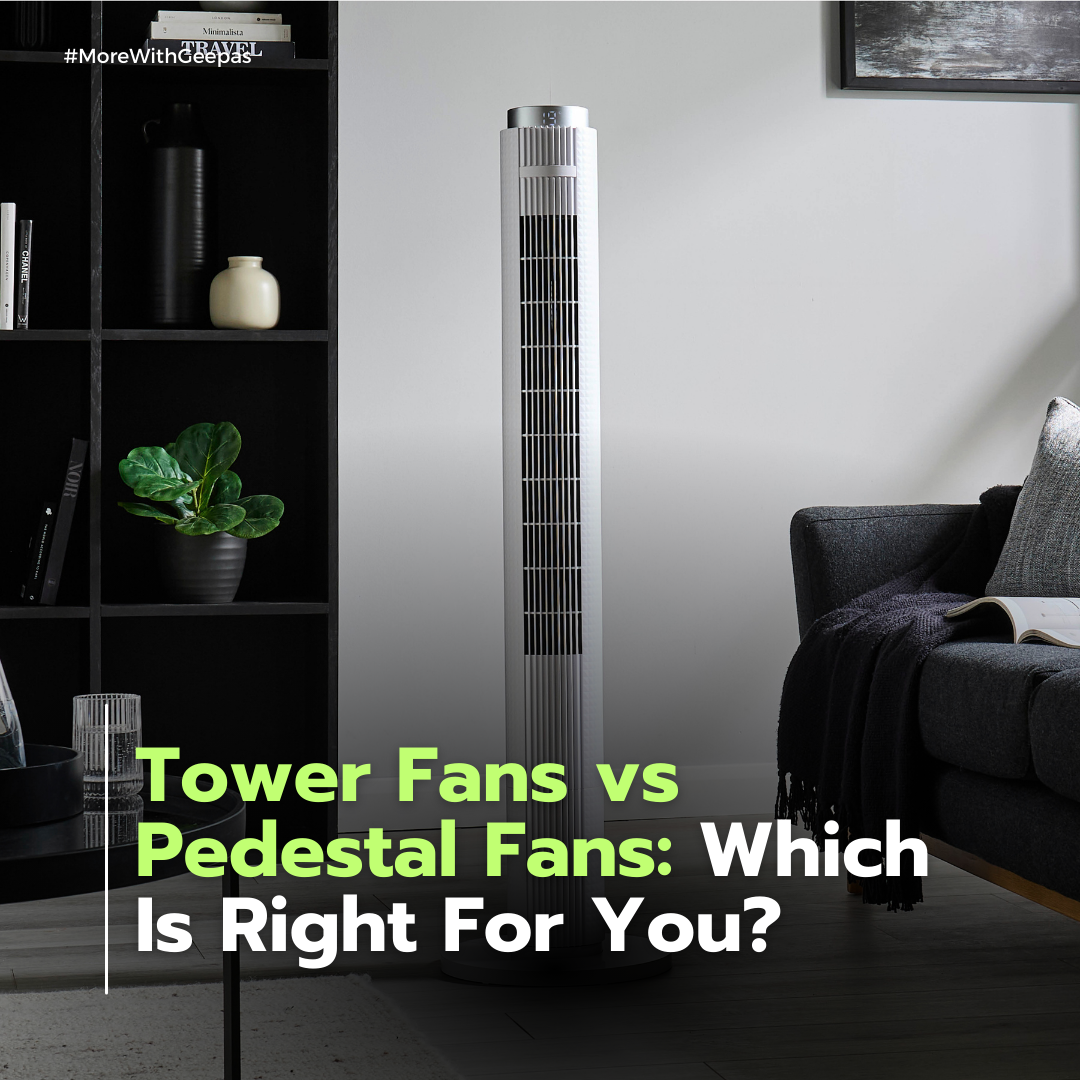As the summer sun heats up, the battle for the coolest spot in the house intensifies . But before you crank up the AC and send your energy bill soaring, consider a trusty fan as your first line of defense against the heat. However, with a variety of fan styles available, choosing the right one can be a breeze (pun intended). This article explores the two most popular options: tower fans and traditional pedestal fans. We'll delve into their features, benefits, and drawbacks to help you pick the perfect cooling companion for your space.
The Towering Appeal: Sleek Design and Focused Airflow
Tower fans, characterised by their tall, slander profile, have become a popular choice for modern homes. These space-saving wonders boast several advantages:
- Aesthetics: Tower fans add a touch of sophistication to any decor. Their sleek, minimalist design blends seamlessly with modern furniture and doesn't overpower a room. They often come in a variety of colors to complement your existing style.
- Space Efficiency: Tower fans take up minimal floor space, making them ideal for smaller rooms, studio, or apartments where every square foot counts. Their vertical design allows for optimal placement near walls or in corners, maximizing usable floor space.
- Focused Airflow: Tower fans typically produce a more focused stream of air, ideal for directing a cool breeze towards a specific area like a desk or couch. This targeted airflow can be particularly beneficial for those who want to cool down a particular spot without affecting the entire room.
- Multi-Speed Settings and Oscillation: Most tower fans offer multiple speed settings to adjust the airflow intensity according to your needs. Many also include an oscillation function that allows the fan to automatically swivel back and forth, distributing cool air more evenly throughout the room.
- Quieter Operation: Tower fans generally operate at lower noise levels compared to some traditional pedestal fans. This makes them ideal for bedrooms, offices, or situations where quiet operation is preferred.
- Safety Features: Some tower fans come equipped with safety features like automatic shutoff timers or tip-over switches, providing peace of mind, especially in homes with children or pets.
While tower fans offer a plethora of advantages, a few things might nudge you towards a different option:
- Limited Airflow Coverage: Due to their focused airflow, tower fans might not be the best choice for cooling down large rooms effectively. The cool air might not reach all corners of the space, leaving some areas uncomfortably warm.
- Higher Cost: Tower fans generally tend to be more expensive than traditional pedestal fans, especially for models with advanced features like oscillation or remote controls.
The Pedestal Powerhouse: Classic Design and Powerful Airflow
The trusty pedestal fan, a mainstay in homes for decades, offers its own set of benefits:
- Powerful Airflow: Pedestal fans are known for their ability to generate a strong, wide-reaching airflow, making them ideal for cooling down large rooms to open-plan living areas. This powerful blast of air can effectively circulate air throughout the space, creating a more consistent cooling experience.
- Adjustable Height: Pedestal fans offer adjustable height settings, allowing you to direct the airflow where it's needed most. This is particularly useful for directing cool air towards different seating areas or adjusting the breeze to hit you at just the right height.
- Affordability: Pedestal fans are generally more affordable than tower fans, especially for basic models with fewer features. This makes them a budget-friendly option for those looking for a powerful cooling solution without breaking the bank.
- Versatility: Pedestal fans can be tilted and oscillated to distribute air in various directions. This versatility allows you to cool down different areas of a room or create a more circulated airflow.
- Durability: Pedestal fans have a simple and sturdy design, making them generally more durable than some tower fans. Their simpler construction often means they are less prone to breakdowns or malfunctions.
While the power of a pedestal fan is undeniable, there are a few considerations to keep in mind:
- Footprint: Pedestal fans have a larger footprint compared to tower fans. Their base can take up valuable floor space, especially in smaller rooms. Their height can also be an issue in certain cases.
- Noise Level: Pedestal fans, particularly powerful models, can generate more noise compare to tower fans. This might be a concern for bedrooms or quiet environments.
- Aesthetics: The traditional design of pedestal fans might not suit all modern decor styles. They can appear bulky or visually obstructive in some spaces.
The Final-Fan-Tastic Verdict:
Choosing between a tower fan and a pedestal fan ultimately boils down to your specific needs and preferences. Here' a quick decision tree to help you pick your perfect cooling companion:
Do you prioritise sleek design and space-saving efficiency?
Yes: Opt for a tower fan. Their focused airflow and minimal footprint make them ideal for smaller spaces or those seeking a modern aesthetic.
Do you have a large room that needs powerful air circulation?
Yes: A pedestal fan is your champion. Their wide-reaching airflow effectively cools down expansive areas, making them perfect for open floor plans or large living spaces.
Are you on a budget and prioritize affordability?
Yes: Pedestal fans generally offer a more budget-friendly option, especially for basic models.
Do noise levels play a significant role in your decision?
Yes: Tower fans generally operate more quietly, making them ideal for bedrooms, offices, or situations where quiet operation is essential.
Do you need a fan that can be easily adjusted to target specific areas?
Yes: Both tower fans and pedestal fans offer some degree of adjustability. However, pedestal fans might offer more flexibility in directing airflow.
Once you've considered these factors, you'll be well-equipped to choose the fan that best suits your cooling needs and preferences.
Beyond the basics: Additional Considerations
For those seeking a more feature-rich experience, both tower fans and pedestal fans offer a variety of options:
- Remote control: Operate your fan from the comfort of your couch with a handy remote.
- Timers: Set a timer to automatically turn the fan on or off after a specific duration.
- Multiple Speed Settings: Adjust the airflow intensity to your desired level of coolness.
- Air Purification Features: Some models incorporate air filters to help remove dust and allergens from the air.
- Smart Home Compatibility: Control your fan with voice commands or integrate it into you smart home ecosystem for ultimate convenience.
Explore the Geepas cooling range
Remember, the perfect fan doesn't have to be a one-size-fits-all solution. Consider your space, budget, and desired features to find the fan that will keep you cool and comfortable all summer long. So, get ready to ditch the sweat and embrace the cool breeze with your perfectly chosen fan!




